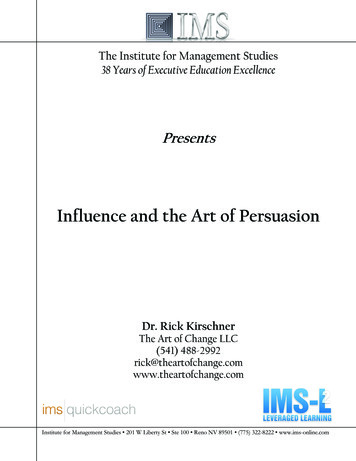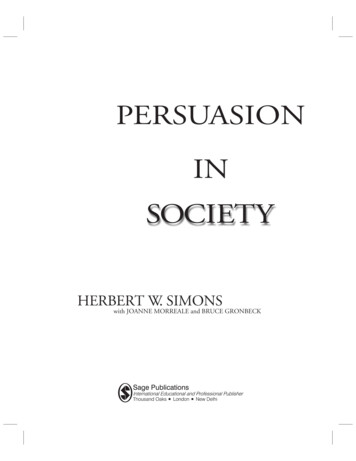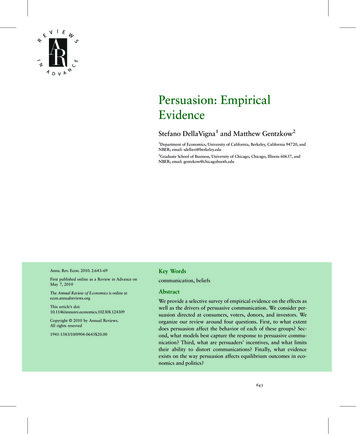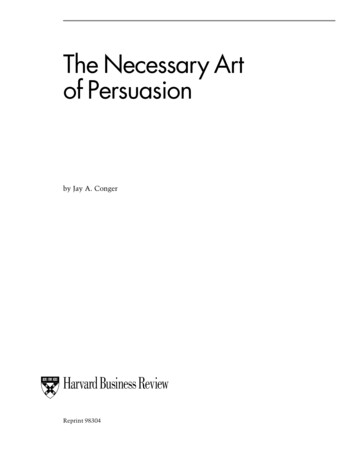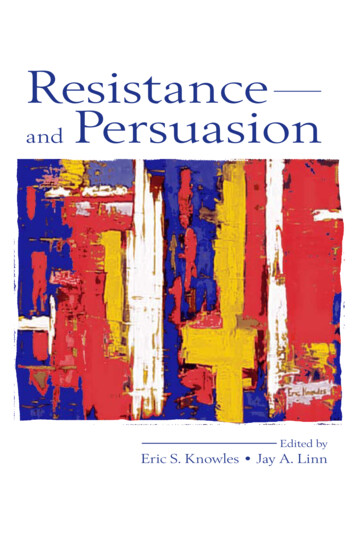
Transcription
Political CommunicationISSN: 1058-4609 (Print) 1091-7675 (Online) Journal homepage: http://www.tandfonline.com/loi/upcp20The Role of Persuasion in Deliberative OpinionChangeSean J. WestwoodTo cite this article: Sean J. Westwood (2015) The Role of Persuasion in Deliberative OpinionChange, Political Communication, 32:4, 509-528, DOI: 10.1080/10584609.2015.1017628To link to this article: w supplementary materialPublished online: 19 Jun 2015.Submit your article to this journalArticle views: 853View related articlesView Crossmark dataCiting articles: 1 View citing articlesFull Terms & Conditions of access and use can be found tion?journalCode upcp20Download by: [Dartmouth College Library]Date: 05 April 2017, At: 14:54
Political Communication, 32:509–528, 2015Copyright Taylor & Francis Group, LLCISSN: 1058-4609 print / 1091-7675 onlineDOI: 10.1080/10584609.2015.1017628The Role of Persuasion in Deliberative OpinionChangeSEAN J. WESTWOODHow does discussion lead to opinion change during deliberation? I formulate and testhypotheses based on theories of persuasion, and examine them against other possiblesources of deliberative opinion change. Through detailed analysis of a nationally representative deliberative event I create a full discussion network for each small groupthat deliberated by recording who said what, the argument quality for what was said,and to whom it was directed. I find that well-justified arguments made in the context of direct engagement between peers are a consistent predictor of opinion change.Individual-level persuasion, not knowledge-driven refinement or extremity, drives mostopinion change. These results show that further deliberative research needs to accountfor persuasion when explaining deliberative opinion change.Keywordspersuasion, deliberationEvidence documenting opinion change after deliberative discussion is strong and consistent, but the causes of opinion change are less clear. There is a significant but shrinkingdivide between the theory used to support (and oppose) deliberative models of consultationand what we actually know about how the processes of deliberation function. In responseto limits to the testability of broad theoretical models of deliberation, some argue for lessidealistic and more testable “middle-range” theories and models of deliberation (see Mutz,2008). In this paper, following Mutz’s (2008) suggestion for research engaging smallercomponents of larger deliberative models. I specifically focus on the role of persuasion onopinion change.Although persuasion is an important part of the process of opinion change, it is underexplored in the current literature. Despite classic psychology and communication researchshowing the importance of the amount and kind of persuasive discussion on opinion formation (see Hinsz & Davis, 1984; Poole, McPhee, & Seibold, 1982), a large amount ofwork on deliberative opinion change does not explore the effects of discussion as a persuasive tool (however, for work on the composition of group discussion on outcomes seeGastil, Black, & Moscovitz, 2008; Karpowitz, Mendelberg, & Shaker, 2012; Luc, 2013;Mendelberg, Karpowitz, & Goedert, 2013). There is good reason to believe that peopleSean J. Westwood is Assistant Professor, Department of Government, Dartmouth College.Address correspondence to Sean J. Westwood, Department of Government, Dartmouth College,211 Silsby Hall, 3 Tuck Mall, Hanover, NH 03755, USA. E-mail: sean.j.westwood@dartmouth.eduColor versions of one or more of the figures in the article can be found online at www.tandfonline.com/upcp.509
510Sean J. Westwoodchange their opinions not just because of the sum total or variety of the presented arguments, but because of the persuasiveness of the arguments and those making them (seeHinsz & Davis, 1984; Sanders, 1997).Discussion is core to deliberation, but there are many theoretical models of deliberation with varying requirements, expectations, and assumptions. Theories of deliberationgenerally suggest that opinions change as a result of discussion and consideration of opinions expressed during discussion (Fishkin, 1997; Gutmann & Thompson, 2004; Habermas,1984; Neblo, 2005). Some models theorize that deliberative opinion change is the result ofthe evaluation of a multitude of different arguments, which ultimately increases knowledgeand thus creates refined opinions (Elster, 1998; Fishkin, 2009; Gutmann & Thompson,2004), while similar work argues that increases in awareness of differing views createsopinion change (see, for example, Kim, & Wyatt, Katz, 1999; Price, Cappella, & Nir,2002). Another body of theory, drawing largely from psychology, is more critical of discussion, and contends that opinion change is the result of movement to more extremepositions after deliberation (Schkade, Sunstein, & Hastie, 2007; Turner, Hogg, Oakes,Reicher, & Wetherell, 1987), and possibly cognitive biases (Sanders, 1997). In all ofthese models, engagement among participants is crucial. Yet, a segment of this literatureassumes—somewhat problematically—that participants not only consider opinions fromother deliberators, but that “the decision-making process must involve discussion of allthe viewpoints, with none of them excluded a priori” (Pellizzoni, 2001, p. 60). Becauseconsideration of arguments is often constrained by the traits and abilities of participants,deliberation has uneven effects on participant opinions. Differing power dynamics elevateand suppress arguments from some participants (Pellizzoni, 2001; Sanders, 1997) and someparticipants in deliberative discussion are simply unable or unwilling to engage in theamount of cognitive work required to fully evaluate all the information presented duringdiscussion (Mendelberg, 2002). One reason for individual differences in opinion change,explored here, is the persuasiveness of arguments made during debate that specificallyengages individual participants.This article addresses important standing gaps in the deliberative literature:Understanding how persuasive interaction affects opinion change and how important persuasion is relative to other sources of opinion change. First, through a novel combinationof large-scale content analysis and social network analysis, I convert complete transcriptsfrom an online deliberative experiment to a discussion network. As part of the contentanalysis, argument quality was assessed using the justification subscale of the DiscourseQuality Index (Steenbergen, Bachtiger, Sporndli, & Steiner, 2003). Together the networkdata and content analysis facilitates a general assessment of the argument quality for eachstatement made during deliberation and a complete map of who talked, what they said,and with whom they debated the issues. The deliberative event occurred over a series ofmeetings dedicated to specific issues and included a robust set of knowledge and opinionmeasures. I scale the effect of persuasion on individual opinion change against two theorized sources of opinion change across a number of issues: knowledge gain and the effectsof polarization. Results show that persuasive argumentation is both the largest and mostconsistent indicator of opinion change. Although a Deliberative Poll is the source of datafor this manuscript, my findings apply to the richer and more expansive body of deliberation research created concurrent to the Deliberative Polling model. Indeed, deliberativedesigns where interaction occurs over a longer period of time and where more individualsare able to share a larger number opinions are likely to produce more justified persuasivearguments.
Persuasion and Deliberative Opinion Change511Studying Deliberative DiscussionThe first empirical work studying the process of deliberation was quite basic and focusedlargely on “simple input-output models of deliberation effects and [did not test], for example, whether the content and structure of actual citizen discussions follows normativeassumptions . . . ” (Price, Nir, & Cappella, 2005, p. 5). By relying solely on differencesin survey responses collected pre- and post-deliberation (e.g., Luskin & Fishkin, 2002;Sunstein, 2009), this work infers the success or failure of group discussion without directlyassessing the actual content of discussion, and therefore does not determine the causal effectof discussion on opinion change.Recent research, however, employs more sophisticated methods to test theoreticalassumptions on the effects of discussion during deliberation by exploring the actual content of discussion. For example, analysis of deliberative discussion shows that exposureto differing viewpoints increases understanding of the perspectives of others (Price et al.,2002). The composition of deliberative groups and the topics they discuss significantlychanges what is said during deliberation (Karpowitz et al., 2012; Mendelberg et al., 2013;Price et al., 2005). Moreover, responsiveness to deliberative discussion and the kinds ofarguments shared during discussion is contingent on the framing of the issue under discussion (Druckman, 2004; Price et al., 2005), and the salience of the issue to the individualsdeliberating (Barabas, 2004). The presence and quantity of substantive debate and disagreement also significantly improves perception of deliberative satisfaction (Stromer-Galley &Muhlberger, 2009), showing that the content of deliberation is not merely a mechanismdriving opinion change but something that is both appraised and valued by participants. Theevidence shows that differences in the content of discussion result in different deliberativeoutcomes, and that the deliberative environment itself alters the content of discussion.Persuasion and Opinion ChangeDecades of data from social psychology research on group dynamics suggest that persuasion drives—or at least contributes to—opinion change during group discussion.Persuasion, simply conceptualized, is a process of attempts to change attitudes. Here Iconsider both the process of persuasion and what kinds of arguments are made during persuasive interactions during deliberation. Again, this work is not intended to evaluate thesuccess or the validity of larger models of deliberation, but simply to document the effectsof persuasion on opinion change during deliberative discussion.The study of social influence and persuasion, especially in the context of decisionmaking bodies, traces back to the founding of social psychology as a discipline (Allport,l935; Kelman, 1961). The foundational work on persuasion demonstrates that the receptionof persuasive messages is conditional on the source of a message, the content of a messageand the audience receiving the message (Festinger, 1964; Howland, Kelley, & Janis, 1954;McGuire, 1968). Known as systematic models of persuasion, these models require a greatdeal of cognitive effort. In rigid conceptualizations, the systematic model assumes thatreceivers pay attention to messages, evaluate the logical structure of arguments, and assessboth their own status and the status of the persuader before forming or changing opinions.When people expend the cognitive effort to evaluate and consider message content, datashow that persuasive argumentation causes opinion change (e.g., Chaiken & Eagly, 1976).However, people often do not carefully consider the information they receive andinstead superficially process information using heuristics (Chaiken, 1980; Chaiken &Trope, 1999). When processing heuristically, the content or logic of a message is not as
512Sean J. Westwoodcarefully considered; instead past experiences and more superficial aspects of a messagecan cause (or prevent) opinion change. For example, when processing heuristically a person may accept an argument because it came from an expert due to a general expectationthat experts are trustworthy (Chaiken, 1980). Superficial attributes of messages, such as theorder in which statements are presented (Haugtvedt & Wegener, 1994), the simple expression of a new concept (Miller, 1976; Zajonc, 1968), and the assertion of superior externalsupport (Petty & Cacioppo, 1981) significantly affect opinion change. Systematic modelsof persuasion are very compatible with many deliberative theories as they focus on carefulevaluation of messages, while models of heuristic processing are possibly less compatibleas they show that traits external to actual arguments can explain opinion change. In eitherthe systematic or heuristic model, argument quality can change opinion (argument development can function as a cue in heuristic processing). This article does not address whichmodel is best. Instead, I characterize deliberative interactions based on how they may ormay not trigger systematic evaluation.When dealing with information individuals prioritize cognitive processing based onissue salience and cognitive ability (Chaiken, 1980; Petty & Cacioppo, 1986). Somedeliberative statements garner the full cognition required in the systematic (central) processing pathway, but some go through the peripheral pathway where full considerationis replaced by heuristic judgments. The process of discussion—distinct from the contentof discussion—changes cognitive evaluation and prioritization. Direct discussion betweenindividuals increases the perception of salience and the likelihood that messages exchangedbetween the individuals are processed systematically and not heuristically. When attempting to engage or persuade, the use of triggers such as “you” or the remembrance and use of aperson’s name consistently increase persuasive effectiveness and compliance with requestsand messages (Howard, Gengler, & Jain, 1995; Shavitt & Brock, 1986). The identificationof a specific individual by a speaker also increases personal relevance and investment in amessage. Interactions directed at a specific person within a group are therefore functionallydifferent from group statements, and are consequently processed differently by receiversbecause of more sophisticated cognitive processing (e.g., Petty & Cacioppo, 1984). Forpersuasion to have maximal impact on attitudes, it should ideally be well justified by thesender and systematically processed by the receiver. An efficient way to trigger systematicprocessing is to increase perceived salience of a message by a receiver, which, according to prior research, dyadic interaction (debate between individuals) should accomplish.Institutional designs can incentivize cognitive elaboration and systematic processing, andset norms that such consideration is expected, but even with these expectations the natureof human cognition persists and the traits of individuals and arguments should persist.Scaling the Effect of Persuasion Against Other Sources of Opinion ChangeA key purpose of this article is to compare the effects of persuasion to other suspectedsources of opinion change. I scale the effects of persuasion against the effects of learningabout issues and the effects of extremity from group attitudes. By exploring these differentmechanisms I can determine the magnitude of persuasive effects against other possiblesources of opinion change.Opinion Shift from Knowledge GainsSubstantial normative heft supports the proposition that knowledge gains drive opinionchange. After all, political knowledge is key to policy opinions (e.g., Gilens, 2001), and
Persuasion and Deliberative Opinion Change513knowledge consistently moderates many political attitudes and behaviors (Bartels, 1996;Delli Carpini & Keeter, 1996; Zaller, 1992). While the link between knowledge gainsand deliberative opinion change is frequently cited (see Eveland, 2004; Luskin & Fishkin,2002), it is often not explained as an individual-level process (for an exception, see Gastiland Dillard, 1999) but rather as aggregate group changes. Strikingly, in some—thoughnot all—deliberative events, knowledge actually decreases over time (Denver, Hands, &Jones, 1995). Following the American National Election Studies and other standard instruments, deliberative studies often operationalize knowledge as a series of questions thatparticipants answer before and after deliberation, or in some designs only at the end ofdeliberation. After deliberation, significantly more participants correctly answer some (butnot all) factual questions, such as the number of parks in a city (Fishkin, He, Luskin, &Sin, 2010), the party in control of the state legislature (Fishkin, 2011), or general civicsquestions (Price et al., 2002). Many assert that these two measures are not simply correlated, but that knowledge directly drives opinion change. This is problematic as (a) a largesubset—sometimes a majority—of participants do not gain knowledge during deliberation,and (b) there is little evidence to suggest that knowing answers to factual civics questionsis sufficient to drive changes in opinion, especially considering that when national, salientissue-knowledge questions are asked, “gains in issue-knowledge are modest at best” (Price,2009, p. 15).Evidence showing that changes in knowledge cause changes in opinion during deliberation is mostly derived from correlations between pre- and post-deliberation knowledge(for some evidence, see Eveland, 2004; Luskin & Fishkin, 2002). While models showingthe correlation between knowledge and opinion change are often significant, these resultsdo not explain how deliberation creates the observed effects. Nonetheless, opinion changesfrom knowledge gains are, based on attention in the literature, worthy of comparison topersuasion.Opinion Shift and PolarizationPolarization in the context, of deliberation largely focuses on group movements and notindividual opinion change (Bray & Noble, 1978; Fishkin et al., 2010; Schkade et al.,2007; Sunstein, 2009). Critics of deliberation contend that discussion with dissimilar peerscreates opinion change by driving participants to hold more extreme positions after deliberation relative to their original opinion or relative to the original position of the group. It isargued that polarization—defined both as a movement toward more extreme positions onissue scales and movement toward a more extreme overall group opinion—causes opinionchange because of group effects on individual attitudes.There is evidence to support these theories of opinion change. People adopt moreextreme (not necessarily more risky or group-consistent) positions after group discussionacross a wide variety of attitudinal measures (Moscovici & Zavallon, 1969). However,outside of deliberation (both judicial and political) those investigating the psychologicalprocesses of interaction have largely abandoned research on risky shifts—the tendencyto adopt riskier positions after group engagement—within groups in favor of research onhow groups and group processes—like persuasion—influence individuals (Reis, 2010).As Chambers (2003, p. 319) notes, “[t]he significance and limitation of the group polarization research comes to light if we read it alongside other experimental data.” Ratherthan focusing on group opinion, I directly assess the effect of deliberation on movementtoward more extreme attitudes and toward the initial attitudes of the group. I compare theseeffects to persuasion and knowledge changes.
514Sean J. WestwoodDefining the meaning of polarization in deliberation is outside the scope of this article,but to offer a fair assessment of discussion and polarization I will look for effects consistent with both conceptions of polarization—movement toward the polar extremes on issuequestions and movement toward the pre-deliberation group opinion.HypothesesI offer and test specific hypotheses explaining opinion change during deliberation. Thehypotheses are not mutually exclusive—all are supported by theory and could reasonablyaccount for opinion change.First, given the importance of persuasion on opinion change in other discussion environments, and that well-argued and salient persuasive messages are more likely to havestrong effects, I hypothesize (H1) that persuasive interaction causes opinion change in thedirection of the position of the persuader. The literature on the cognitive response to persuasive messages shows that justified and salient messages are likely to cause opinion change.To test this hypothesis I code each message exchanged during a deliberative event for argument quality and identify the intended target (receiver) of the message. The hypothesiswould be supported if justified messages with high salience (messages intended for specificindividuals) cause opinions to change. Furthermore, I expect that opinion change causedby persuasion will result in opinion change in the direction of the ideological content of themessage (i.e., more conservative messages cause more conservative opinions).Second, acquiring knowledge should cause opinion change. Therefore, I hypothesize(H2) that increases in knowledge cause opinion change. People who learn during discussionshould provide changed opinions at the end of discussion. To test this hypotheses I compareopinion change for those who learned and those who did not learn.Third, I hypothesize (H3) that people are not merely adopting more extreme positionsas a result of deliberation. If people are responsive to persuasion, then movements shouldnot be caused by either group or individual attitudinal extremity. To test this expectation Ilook at how individuals’ attitudes shift toward and away from the extremes (both scale endpoints and pre-deliberation group mean attitudes) after discussion.Finally, I hypothesize (H4) that individuals are not merely moving toward the initialattitude of their discussion group. To test this expectation I look at the effects of initialgroup attitudes on opinion change across a series of issues.I test these hypotheses together and individually in the following analyses.Data and MeasuresData come from the “2004 Online Deliberative Poll on the Primaries.” A group of284 deliberators gathered from the Knowledge Networks panel participated in five onehour discussions of issues related to major U.S. political issues in January 2004. A controlgroup of 460 individuals that did not deliberate and only completed pre- and post- interviews was also drawn from the Knowledge Networks panel. Participants without Internetaccess were given a computer equipped with Internet access, participants who already hada computer and Internet access were offered an honorarium of 200, and members of thecontrol group were offered an honorarium of 40.Participants were randomly assigned to one of 16 small groups for discussion. Eachgroup met online using voice-chat software that allowed participants to hear but not see oneanother. The use of an online sample is particularly advantageous to this study to controlfor possible effects of status, as it was not possible to detect the composition of the group
Persuasion and Deliberative Opinion Change515without keeping notes on the gender and age of each participant as they talked (if thesetraits could be discerned by voice alone). This is especially important given that groupdemographic composition has strong effects on engagement and opinion change (e.g., seeKarpowitz et al., 2012; Mendelberg, 2002; Mendelberg et al., 2013). While not intendedas part of the original design, the use of an online voice-chat system likely mitigates theimportance of traits indicating status. It is also possible that cues present in face-to-facedeliberation (race, age, and gender) are discernible from voices, but the elimination ofvisual interactions reduces the observability of these traits.A moderator was present in each group to ensure decorum, to provide technical assistance, and to convene each discussion session. Participants were free to talk to the entiregroup, ask questions of one another, and to engage in debate among one another. Transcriptsfor one small group were missing and were excluded from analysis. The final number ofparticipants included in this analysis was 264. The average small group size was 15.53(SD 2.95).Content AnalysisStatements from each of the 15 small groups (75 hours of total deliberation) were algorithmically coded for direct references to other participants and converted into directed edgelistformat (a form of data where every interaction is listed as a single row with informationon the message sender and message receiver as columns).1 A group of 14 human coders (asubset of three for each statement) then verified the computer assessment of all statementsin the sample. The humans also coded each statement for argument quality as explainedlater. Wherever disagreement occurred, the majority opinion was used.The quality of arguments presented in deliberation was determined with the justification scale from the Discourse Quality Index (DQI) developed by Steenbergen andcolleagues (2003). The full DQI is comprised of several measures of discourse and isdesigned to assess parliamentary debate. Here I focus only on the justification componentas this is the interest of the article and because this measure is not specific to parliamentarydiscussion. Statements were coded into four categories: (0) No justification, (1) Inferior justification, (2) Qualified justification, and (3) Sophisticated justification. Overall intercoderreliability was high (Krippendorff’s alpha .83).2Peer Interactions As Social Network DataThe deliberative environment allowed all participants to see the names of other participantsand to request the microphone at any time. Participants were free to direct comments tothe group, to single individuals or to many individuals. All participants were present for allstatements, but there are several important differences between statements directed to thegroup and statements directed to another participant. Messages to the group were usuallygeneral, while messages directed to another participant were explicitly identified as foranother participant (references by name) or implicitly identified as for another participant(references to the “last speaker,” “the person before me,” etc.).While deliberating, participants offered 4,096 statements, of which 2,332 were directlyrelated to topics of deliberation. Statements to and from moderators, greetings, technicalsupport questions, and inaudible comments were removed from the data. Each statementwas, as part of the coding process, classified as a statement to the group as a whole or asa statement directed at a specific participant. For example, in discussion when “participantx” referred to a point made by “participant y,” this statement was recorded as a statement
516Sean J. Westwooddirected at “participant y” from “participant x.” These interactions occurred in front of thegroup, but were dyadic in nature and constitute most of the substantive debate and discussion in the deliberative groups. The coding was initially completed with custom softwarethat identified references to other participants. Human coders used a second custom software tool to process all interactions and to verify results identified by the software. Dataon interactions between individuals identified from the content analysis of the group transcripts were structured as network data. This process allows for comprehensive mapping ofall interactions between participants and for all participants.With the data from the content analysis it is possible to assess both the number ofdirected statements directed toward each participant, and the level of sophistication ofeach statement. For each of the main deliberative issues the number of interactions foreach participant from more conservative peers and more liberal peers was recorded. Peerinteractions were limited to instances of substantive and justified arguments.Survey DataThe overall political knowledge measure included seven factual knowledge questions and24 candidate issue-placement questions (identifying whether candidates support or opposepolicy issues). The overall measure was a percentage of correct responses to the 31 questions.3 Average inter-item correlation was .3. Discussion within the Deliberative Pollfocused on major issues salient to the national political landscape in January 2004, withattitudes measured pre- and post-deliberation. All questions were captured with 5-pointLikert-like scales and were coded with a neutral midpoint. Seven specific areas of policypreference and two economic outlook questions were captured in the poll questionnairesand are reported in Table 1. Opinion change was calculated by subtracting attitudes reportedat the start of deliberation (T1) from attitudes reported after deliberation (T2). Informationon those at the midpoint at both T1 and T2 is reported in the appendix in the SupplementalMaterial.In the following analysis these questions are scaled such that higher scores reflect theliberal position and lower scores reflect the conservative position. Liberal and conservativepositions were determined by the average response by Democrats and Republicans in thesample, which in all cases were on opposing sides of the scale midpoints. Average opinionchange was not consistent between issues either in direction or significance, which itself isan important finding. One possible explanation for this discrepancy is framing effects (seePrice et al., 2005)A measure of extremity from the group at T1 was also generated. The measure follows the design of Fishkin and colleagues (2010) and Sunstein (2009) and was constructedby taking the absolute value of the difference between each respondent’s T1 attitude andthe median T1 attitudes of the respondent’s discussion group (excluding the respondent).This measure indicates how far from the group median each respondent was at the start ofdeliberation.ResultsI present my findings in three parts. I first show that dyadic debate is highly justified. Next,I show that dyadic interaction has strong effects on opinio
Download by: [Dartmouth College Library] Date: 05 April 2017, At: 14:54 Political Communication . The Role of Persuasion in Deliberative Opinion Change Sean J. Westwood To cite this article: Sean J. Westwood (2015) The Role of Persuasion in Deliberative Opinion Change, Political Communication, 32:4, 509-528, DOI: 10.1080/10584609.2015.1017628


